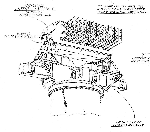NavSource Online: Battleship Photo Archive
BB-38 USS PENNSYLVANIA
To Additional Pages
Please Report Any Broken Links Or Trouble You Might Come Across To The Webmaster.
Please Take A Moment To Let Us Know So That We Can Correct Any Problems And Make Your Visit As Enjoyable And As Informative As Possible.
| Click On Image For Full Size Image | Size | Image Description | Contributed By And/Or Copyright |
|
|---|---|---|---|---|
 | 341k | Radar Equipment Mk.8 Mod.1 The Antenna of Mk.8 Mod.1 was a 14-element MUSA (multi-unit-steerable-antenna) array in which the elements were horizontally aligned in broadside. That provided the necessary horizontal directivity and permitted the radiation lobe to be steered without antenna motion, changing the phase difference between adjacent radiators. It was supported on top the directors Mk.34 and Mk.38 by an arrangement that moved it up or down to compensate for ship motion. It could be levelled between +15- and -15 degrees. 42 tapered, solid polystyrene rods (polyrods) projected from it in 14 vertical groups of 3. Each rod was about 3 ft. long and fitted into the end of a waveguide that supplied voltage for it. A group of 3 rods was called a trident and functioned as a separate element of the antenna. Scanning was accomplished by means of 13 mechanical phase shifters that continually shifted the phase of the voltages supplied to the tridents. They rotated in ball bearings, driven by a motor, mounted at one end of the antenna. Near this drive motor, a gear-shift motor was mounted for 2-speed scanning. Auxiliary equipment allowed the operator to start, stop or reverse the scan or select scanning speeds. A synchro generator was mounted on the assembly for indications at a remote point of the position of the antenna lobe during low-speed scan. During high-speed scan, a solenoid clutch disengaged the synchro generator. This radar equipment was used primarily for Main Battery fire control. Range accuracy was excellent. Bearing accuracy was practically as good as optics. Spotting in range was excellent. Fall of shot within 1000 yards of target range was accurate to the nearest 100 yards. Spotting in bearing was not practical for small deflection errors. The antenna was stabilized in level from the stable vertical in Main Battery Plot or local rangefinder. Level input to the antenna was necessary since the narrow beam would roll above and below the target if the antenna was not held on level. Range was transmitted to Main Battery Plot electrically. All operating and control units were at first mounted in the director, later some of it was mounted in Main Battery Plot. Operation required 1 radar operator and the director train operator. The range at which surface targets could be reliably detected exceeded the range of the battleship's 16-inch /45 cal. guns and rangekeepers. Range and bearing discrimination was good. Important tactical information regarding the composition of targets could well in advance to action be obtained. Three sweepes were provided: Main, Expanded & Precision sweeps. Main sweep made it possible to see to about 90,000 yards. Range measurement to only 45,000 yards. This sweep was used for initial contacts and for obtaining tactical information concerning number, disposition and movement of targets. Expanded sweep made it possible to expand the first 20,000 yards of range for better range discrimination. Precision sweep selected a given range indicated on the range unit and showed any target within 1000 yards of this range in proper range relation. It was used out to 45,000 yards. Range spotting was obtained by using precision sweep and high-speed bearing sweep. | USN photo and text courtesy of Pieter Bakels. | |
The contact listed, Was the contact at the time for this ship when located. If another person now is the contact, E-mail me and I will update this entry. These contacts are compiled from various sources over a long period of time and may or may not be correct. Every effort has been made to list the newest contact if more than one contact was found.
| Back To The Main Photo Index | Back To The Battleship Photo Index Page |